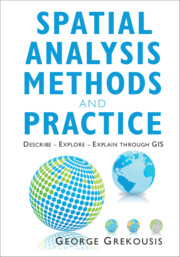Book contents
- Spatial Analysis Methods and Practice
- Reviews
- Spatial Analysis Methods and Practice
- Copyright page
- Contents
- Preface
- 1 Think Spatially
- 2 Exploratory Spatial Data Analysis Tools and Statistics
- 3 Analyzing Geographic Distributions and Point Patterns
- 4 Spatial Autocorrelation
- 5 Multivariate Data in Geography
- 6 Modeling Relationships
- 7 Spatial Econometrics
- References
- Index
2 - Exploratory Spatial Data Analysis Tools and Statistics
Published online by Cambridge University Press: 20 May 2020
- Spatial Analysis Methods and Practice
- Reviews
- Spatial Analysis Methods and Practice
- Copyright page
- Contents
- Preface
- 1 Think Spatially
- 2 Exploratory Spatial Data Analysis Tools and Statistics
- 3 Analyzing Geographic Distributions and Point Patterns
- 4 Spatial Autocorrelation
- 5 Multivariate Data in Geography
- 6 Modeling Relationships
- 7 Spatial Econometrics
- References
- Index
Summary
This chapter deals with
The notion of exploratory spatial data analysis
The presentation of descriptive statistics
Spatial statistics and their importance in analyzing spatial data
Analyzing univariate data
Simple exploratory spatial data analysis tools such as histograms, boxplots and other visual methods to get a better insight of spatial datasets
Bivariate analysis
Correlation and pairwise correlation
Normalization, rescaling and adjustments
An introduction of basic notions of statistical significant tests
The importance of hypothesis setting in a spatial context
The importance of normal distribution in classic statistics and how it is integrated into spatial analysis
After a thorough study of the theory and lab sections, you will be able to
Have a solid knowledge of descriptive statistics
Use descriptive statistics for univariate analysis
Understand and use exploratory spatial data analysis techniques to map and analyze variables attached to spatial objects
Create several plots, link them to maps and identify interesting patterns of data
Conduct bivariate analysis, identify whether two variables are linearly related and use plots to further examine their relation
Rescale data to make comparisons between variables easier and also allow for better data handling
Apply ESDA tools through ArcGIS and GeoDa
Keywords
- Type
- Chapter
- Information
- Spatial Analysis Methods and PracticeDescribe – Explore – Explain through GIS, pp. 59 - 146Publisher: Cambridge University PressPrint publication year: 2020

